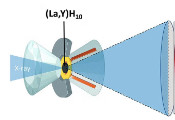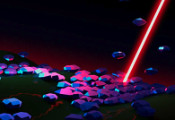Primordial Naked Singularities: Nature’s Quantum Gravity Laboratories Pervading the Universe?
January 09, 2025 -- Two Indian physicists have theoretically proposed a path-breaking idea which could fundamentally change the current view about the contents of the universe and potentially provide ways to probe a holy grail of physics, namely the quantum gravity. Professor Pankaj Joshi from Ahmedabad University, India (earlier at the Tata Institute of Fundamental Research [TIFR], India) and Professor Sudip Bhattacharyya from TIFR have shown that gravitational collapse of matter in the early universe could give rise to incredibly dense point-like objects, namely visible or naked singularities, which could account for a significant fraction of unseen matter in the universe. This research will be published in the prestigious international academic journal, the Journal of Cosmology and Astroparticle Physics (JCAP).
When our current observed universe originated in an explosive Big Bang Singularity event, the states of matter there in terms of temperatures, densities, and other aspects were extreme. Well-known physicist Stephen Hawking suggested in 1971, further to a similar proposal in 1966 by Yakov Zeldovich and Igor Novikov, that there must be what are called ‘Quantum Fluctuations’ in the early universe phase. When sufficiently strong, these lead to gravitational shrinking and collapse of extreme high density matter blobs present there. It was suggested this would create primordial black holes (PBHs) in an ample measure in the early universe.
A black hole is an exotic cosmic object predicted by Einstein’s theory of General Relativity. It does not have a hard surface, and its matter is almost infinitely dense. This matter, namely singularity, is hidden within an invisible boundary, called an event horizon, from within which nothing, not even light, can escape. Thus, one cannot observationally access this singularity and the extreme region within the event horizon in the case of black holes.
It was proposed that primordial black holes could constitute a significant fraction of the dark matter. Dark matter accounts for about a quarter of the contents of the present universe and there is about five times more dark matter than the visible, normal matter. Yet, we do not know with certainty what this mysterious dark matter is made of, and hence it is a fundamental problem of physics and cosmology. Extensive research has continued by scientists worldwide on primordial black holes, and their implications for the issues of dark matter are being investigated tirelessly.
In the new research, Professor Joshi and Professor Bhattacharyya have shown that the gravitational collapse in the early universe phase could also lead to visible or naked singularities where the singularity is not covered by an event horizon. Thus, such primordial naked singularities (PNaSs), unlike in case of black holes, could be observationally accessible. This ultra-strong gravity condition provides a unique and excellent opportunity to probe new fundamental aspects of physics of the universe including quantum gravity. It is currently thought that understanding the quantum gravity is a last major frontier of physics where one aims to build a consistent theory involving two great new theories of the 20th century physics – quantum theory and Einstein’s theory of gravity.
If PNaSs account for a large fraction of the dark matter, then a significant part of the universe could be made of almost infinitely dense point-like objects, that is singularities, which can be observationally accessible. This tantalizing possibility of having visible singularities pervading the universe could change the current view about the universe. PNaSs could, in principle, reveal observable quantum gravity effects and hence serve as natural laboratories to test proposed theories of quantum gravity. These ancient exotic objects, which are as old as the universe itself, will also open up the physics of the extreme region around the singularity to scientists, a region which is inaccessible for black holes.




































